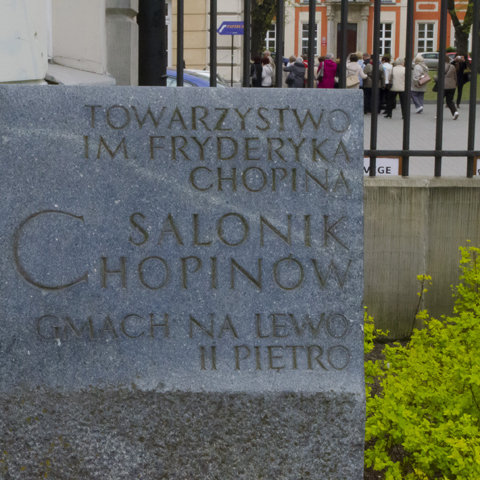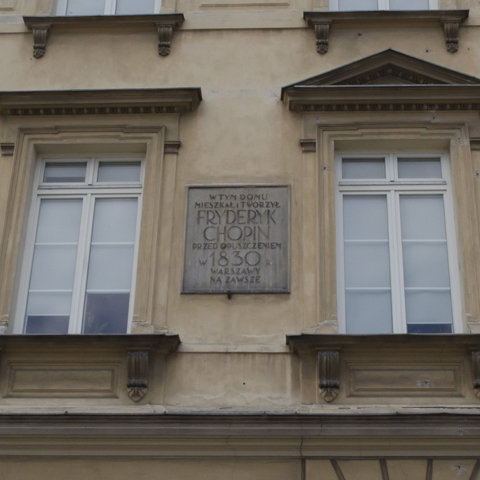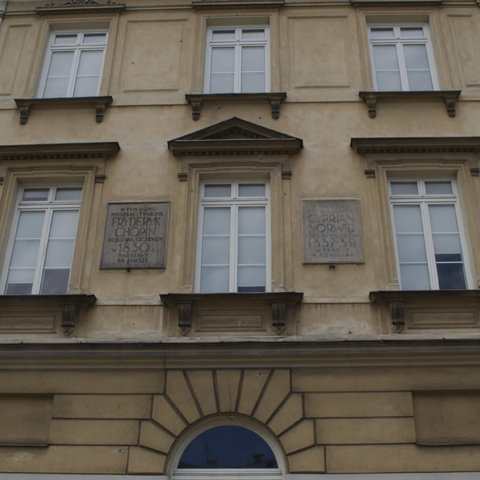Composers / Fryderyk Chopin / Places catalog
Czapski (Krasiński) Palace
On 6 July 1827, Chopin wrote to his parents and sister from Kowalewo: ‘Since my health serves me like some sort of trained dog, [and Mr] Zboiński’s little yellow eyes are downcast as we set off for Płock, it would be madness if, for my part, I were not to report about this. And so, today in Płock, tomorrow in Rościszewo, the day after tomorrow in Kikół, a few days in Turzno, a few days in Kozłowo, a moment in Gdańsk, and then back again! – Perhaps someone will say, “it’s obvious that he’s in a hurry to get home, since he mentions it.” No, no, not in the least, Your Lordship or Your Ladyship is very wrong, for I wrote this only to arouse the pleasant feeling that we are used to experiencing when we greet each other. Just who would be yearning for home? … Not I in the least. Some other person might yearn, but not I! … But for all of this, there is no letter from Warsaw, Today in Płock I will turn the entire post upside down, if only something would be there for me. So how are you doing in your new lodgings?’
The ‘new lodgings’ that the young Chopin, homesick and eager for news, was asking about was an apartment in a rented annexe in Czapski (Krasiński) Palace that the Chopins occupied in 1827–1835. It was probably on the second floor, beneath a little room for Fryderyk in the attic, described by him in an 1828 letter to Tytus Woyciechowski as follows: ‘There’s already a room upstairs that is intended to serve my convenience; stairs have been made from the closet leading into it. There I am to have an old piano and an old desk. It is to be my corner for hiding away’.
In March 1830, the Piano Concerto in F minor and the Fantasy on Polish Airs were rehearsed in the Chopins’ drawing room at Krakowskie Przedmieście 5. This was reported enthusiastically by the Powszechny Dziennik Krajowy [Polish national daily]. The reviewer summed it up: ‘To repeat the opinion of the most distinguished people there: “Young Szopen [Chopin] surpasses every pianist we have ever heard. He is the Paganini of the piano…”’. The interior of this, the last Warsaw residence of Fryderyk Chopin, was captured for posterity by Antoni Kolberg, who sketched it and painted it in watercolour in 1832. Kolberg wrote on the back of the watercolour: ‘The Chopins’ living room in Krasiński Palace, annexe to the left of the main building, second floor, 1832, after the departure of Fryderyk. I sent the original to him in Paris’. The sketch, like the watercolour, was lost during the Second World War. It is known to us from a reproduction in Leopold Binental’s book Chopin. W 120-tą rocznicę urodzin. Dokumenty i pamiątki [Chopin. On the 120th anniversary of his birth: documents and memorabilia]. This sketch informed the arrangement of the ‘Chopin Family Drawing Room’, which has been open to the public in what is now the Academy of Fine Arts since 1960.
-

Czapski (Krasiński) Palace. Phot. Waldemar Kielichowski.
-

Memorial plaque. Phot. Waldemar Kielichowski.
-

Memorial plaque. Phot. Waldemar Kielichowski.
-

Memorial plaque. Phot. Waldemar Kielichowski.